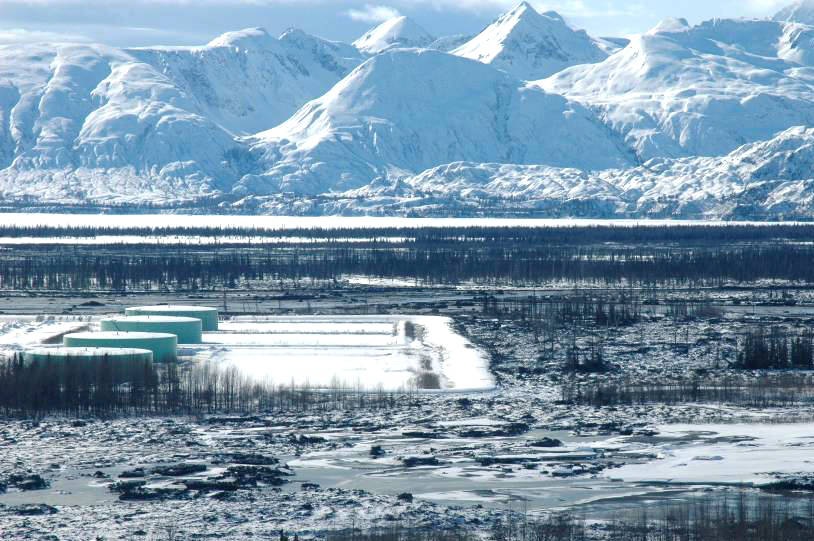With oil expected to begin flowing in September through a reconfigured pipeline system connecting fields on the west side of Cook Inlet to the Andeavor Refinery on the east, Hilcorp’s Drift River Oil Terminal — from which oil is presently carried across the inlet by tanker — may start being dismantled in early 2019.
On June 5 Hilcorp’s pipeline-owning subsidiary Harvest Alaska — through its own subsidiary Cook Inlet Pipeline Company, Drift River’s operator — filed for permission to dismantle the terminal with the Regulatory Commission of Alaska, the state agency that oversees energy infrastructure.
This fall Hilcorp plans to finish an approximately $73 million project to reconfigure an existing underwater pipeline between Beluga and Ninilchik to carry oil instead of natural gas, and move the displaced gas instead through a pipeline that presently connects Hilcorp’s Tyonek platform to the inlet’s east side. The plan requires about six miles of new pipeline to complete the connection from the Tyonek platform to the west side’s existing onshore pipeline system. Hilcorp began assembling the pipe onshore this winter and installing it in the water this spring.
The west side oil pipeline system presently collects crude from several fields and platforms at Drift River, where seven tanks can hold about 270,000 barrels of oil each. Tankers dock offshore at the Christy Lee Loading Platform, which is connected to the tank farm by a pair of 2.7 mile-long pipelines. While decommissioning Drift River, Hilcorp plans to disconnect the platform by removing its pipelines and putting it in an inactive “lighthouse” mode — with U.S Coast Guard-required navigation lights, fog horn, and corrosion protection — until deciding to remove it in the future. At least four other platforms in Cook Inlet are similarly lighthoused, according to Hilcorp’s RCA filing, and the company plans to save mobilization costs by removing several at the same time.
The threat of oil spills from both cross-inlet tanker traffic and storage at the terminal — which sits in the Drift River Valley about 20 miles from the volcanic Mount Redoubt — has long troubled conservationists and oil-spill specialists.
During Reboubt’s recent eruptions, volcano-triggered floods and lahars — hot flows of mud and debris — have threatened the Drift River terminal. When Mt. Reboubt erupted in December 1989 through January 1990, the terminal was storing 900,000 barrels of oil — almost four times the amount the Exxon Valdez had spilled that March, according to a report to the Cook Inlet Regional Citizen’s Advisory Council. No oil was spilled, but a flood in the terminal prompted Cook Inlet Pipeline Company to build two diversionary dikes on Drift River and surround the facility with a 20-foot wall of concrete-armored earth and gravel.
During Redoubt’s spring 2009 eruption, Drift River was again threatened with lahars and floods that damaged a generator, leading the terminal to be drained of oil and shut down. In subsequent years oil was pumped directly from incoming pipelines to tankers docked at the Christy Lee platform, but after Hilcorp bought Drift River and the Cook Inlet Pipeline Company from Chevron in 2011 it announcing plans to increase oil production, requiring the storage at Drift River to come back into use. Lahars from the 2009 eruption had deposited five to six feet of soil at the base of the wall, which Hilcorp spent about $18.5 million to raise by 15 feet.
Decommissioning Drift River “will reduce the environmental hazards inherent in the marine transport of crude oil by tankers and the storage of large volumes of crude oil below an active volcano,” the RCA filing states. “The proposed system modifications will also substantially reduce the amount of oil that is stored in any one location, thereby mitigating the risk of a large spill of stored oil.”
Hilcorp estimates that decommissioning the tank farm and its pipelines while leaving the loading platform for later removal will cost about $21 million. This will use up most of the $24 million fund for decommissioning Cook Inlet Pipeline Company infrastructure. Details of the plan and its costs are confidential “in order not to give contractors information about the cost breakdown of different parts of the work which will need to be bid out,” according to the RCA filing.
This year Hilcorp plans to spend approximately $300,000 on engineering and planning for project.
Reach Ben Boettger at bboettger@peninsulaclarion.com

